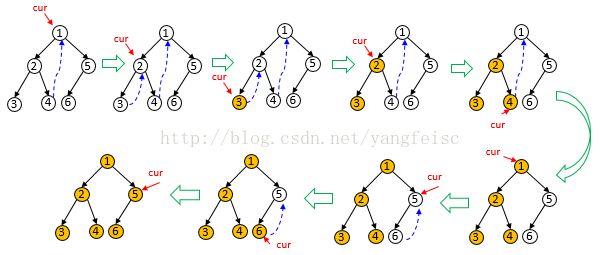二叉树遍历小结
前言
二叉树是相当重要的数据结构,目前我还只会玩玩它的遍历(年轻不懂事没好好学,不然早就达到人生巅峰了),LeetCode上二叉树的简单题,大部分通过遍历加一点小逻辑即可解决,所以总结一下几种遍历方法(其实也是看题解白嫖的)。
二叉树遍历有广度优先,深度优先两种方式,深度优先又分先序遍历(根,左,右),中序遍历(左,根,右),后序遍历(左,右,根),如果是二叉搜索树,中序遍历就是有序的了。广度优先方式没太多说,只能借助队列实现,而深度优先,可通过递归方式,借助栈迭代方式,还有一种巧妙的莫里斯算法,空间复杂度是O(1),但莫里斯算法应该会改变树的结构。
广度优先遍历
首先将根结点入队,然后只要队列非空,就出队一个元素,然后只要子节点不为空就入队,队列为空时,就是遍历完成时
public int bfs(TreeNode root) {
Queue<TreeNode> queue=new LinkedList<TreeNode>();
if(null!=root){
queue.add(root);
}
int depth=0;
while(!queue.isEmpty()){
depth++;
int size = queue.size(); //这两行不要也可以,按queue不为空就可以完成遍历
for(int i=0;i<size;i++){ //size可以控制一层一次循环,可以获取当前的高度
TreeNode curNode=queue.poll();
if(null!=curNode.left){
queue.add(curNode.left);
}
if(null!=curNode.right){
queue.add(curNode.right);
}
}
}
return depth;
}
深度优先遍历
递归方式
递归方式代码很简洁,调整一下顺序前中后序遍历也都出来了。然后不断地嵌套函数调用,不管哪种语言每次函数调用操作系统都需要压栈,JVM中每次方法调用也是需要创建栈帧,如果数据量大会消耗大量内存,肯定会抛出StackOverflowError
1.先序
public void dfs(TreeNode root) {
if(null==root){
return;
}
System.out.println(root.val);
dfs(root.left);
dfs(root.right);
}
2.中序
public void dfs(TreeNode root) {
if(null==root){
return;
}
dfs(root.left);
System.out.println(root.val);
dfs(root.right);
}
根右左遍历
public void dfs(TreeNode root) {
if(null==root){
return;
}
dfs(root.right);
System.out.println(root.val);
dfs(root.left);
}
3.后序
public void dfs(TreeNode root) {
if(null==root){
return;
}
dfs(root.left);
dfs(root.right);
System.out.println(root.val);
}
迭代方式(先序)
深度优先先序迭代遍历,先将根节点入栈,然后只要栈非空,就出栈一个元素,这时需要将右子节点先入栈,左子节点后入栈,这样下一次循环出栈的是左子节点,再继续下去就达到了目的
public List<Integer> dfs(TreeNode root) {
List<Integer> res=new LinkedList<>();
if(null==root){
return res;
}
Stack<TreeNode> stack = new Stack<>();
stack.push(root); //入栈根结点
while(!stack.isEmpty()){
TreeNode curNode=stack.pop(); //出栈最后加入结点
res.add(curNode.val);
if(null!=curNode.right){
stack.push(curNode.right); //先入栈右子结点,后出栈右结点
}
if(null!=curNode.left){
stack.push(curNode.left); //后入栈左子结点,先出栈左子结点
}
}
return res;
}
迭代方式(中序)
深度优先中序迭代遍历,每次循环需要将根节点的所有左结点全部入栈,然后出栈最后一个左子结点,即第一个结点,如果该结点有右子结点,将根节点赋值为该右子结点,接着下一次循环,这样又会把右子树入栈,遍历完后会回到第一次循环的父节点,栈为空后达到目的
public List<Integer> dfs(TreeNode root) {
List<Integer> res=new LinkedList<>();
if(null==root){
return res;
}
Stack<TreeNode> stack = new Stack<>();
while(!stack.isEmpty()||null!=root){
while(null!=root){ //如果左子结点不为空,一值入栈左子结点
stack.push(root);
root=root.left;
}
TreeNode curNode=stack.pop(); //弹出最后一个左子结点
res.add(curNode.val);
if(null!=curNode.right){
root=curNode.right; //右子结点不为空,先处理右字树
}
}
return res;
}
迭代方式(后序)
深度优先后序迭代遍历,每次循环需要将根节点的所有左结点全部入栈,然后出栈最后一个左子结点,如果存在右孩子,入栈当前节点,指针移到右孩子,进入下一轮循环,一样全部入栈左子结点,当右子结点为空,加入遍历结果集,这是将指针值为空并将前驱结点置为此节点(前驱结点就是用于处理有右孩子的结点),下一轮循环,如果结点的右孩子等于前驱结点,也可以加入结果,一直循环到栈为空指针为空,遍历完成
public List<Integer> dfs(TreeNode root) {
List<Integer> res=new LinkedList<>();
if(null==root){
return res;
}
Stack<TreeNode> stack = new Stack<>();
TreeNode pre=null; //前驱结点
TreeNode curNode=root;
while(!stack.isEmpty()||null!=curNode){
while(null!=curNode){ //左子结点一直入栈
stack.push(curNode);
curNode=curNode.left;
}
curNode=stack.pop(); //出栈最后结点
if(null==curNode.right||curNode.right==pre){ //pre为有右子节点的结点的右结点,用于处理有右孩子的父结点
res.add(curNode.val);
pre=curNode;
curNode=null;
}else{ //如果右子结点不为空,入栈右子结点,下轮循环处理右字树
stack.push(curNode);
curNode=curNode.right;
}
}
return res;
}
莫里斯算法
莫里斯算法用巧妙的方式,将迭代遍历的空间复杂度降低为O(1),代码看起来没有多太多,但是理解却是需要更多的脑容量,这里借用了https://blog.csdn.net/yangfeisc/article/details/45673947的图解,有助于理解。
莫里斯先序
1 如果当前结点没有左子树,输出结点,当前结点指向右子结点,遍历右子树
2 如果当前结点有左子树,找到该左字树的最右子结点,如果最右子结点的右孩子为空,代表为根节点,输出结点值,如果最右子结点的右孩子不为空,当前移动到右孩子
3 当前结点为空,结束循环

public List<Integer> morris(TreeNode root) {
List<Integer> res=new LinkedList<>();
if(null==root){
return res;
}
TreeNode cur = root;
while(null!=cur){
if(null==cur.left){ //用于处理最左子结点,最右子结点
res.add(cur.val);
cur=cur.right; //回到后继根节点
}else{
TreeNode pre = cur.left;
while(null!=pre.right&&pre.right!=cur){ //找到左子结点的最右孩子,也就是根节点的前驱
pre=pre.right;
}
if(null==pre.right){ //用于遍历其他结点,根节点,非最左最后
res.add(cur.val);
pre.right=cur; //用于将前驱指向根节点
cur=cur.left;
}else{
pre.right=null;
cur=cur.right; //用于回到根节点,或者移动到右子结点
}
}
}
return res;
}
莫里斯中序
1 如果当前结点没有左子树,输出结点,当前结点指向右子结点,遍历右子树
2 如果当前结点有左子树,找到该左字树的最右子结点,如果最右子结点不为空,代表为最左结点,输出结点值,然后回到父节点,或者右子结点
3 当前结点为空,结束循环

public List<Integer> morris(TreeNode root) {
List<Integer> res=new LinkedList<>();
if(null==root){
return res;
}
TreeNode cur=root;
while(null!=cur){
if(null==cur.left){ //用于处理最左子结点,最右子结点
res.add(cur.val);
cur=cur.right;
}else{
TreeNode pre = cur.left; //找到左子结点的最右孩子,即根节点的前驱结点
while(null!=pre.right&&pre.right!=cur){
pre=pre.right;
}
if(null==pre.right){ //用于将前驱指向根节点
pre.right=cur;
cur=cur.left;
}else{
res.add(cur.val); //用于处理其他结点,左节点
pre.right=null;
cur=cur.right; //用于回到根节点,或者移动到右子结点
}
}
}
return res;
}
莫里斯后序
public List<Integer> morris(TreeNode root) {
List<Integer> res=new LinkedList<>();
if(null==root){
return res;
}
TreeNode temp =new TreeNode();
temp.left=root;
TreeNode cur =temp;
while(null!=cur){
if(null==cur.left){
// res.add(cur.val); //最左子结点与最右子结点不再处理
cur=cur.right;
}else{
TreeNode pre=cur.left;
while(null!=pre.right&&pre.right!=cur){ //找到最右子结点,于根节点建立前驱联系
pre=pre.right;
}
if(null==pre.right){
pre.right=cur;
cur=cur.left;
}else{
pre.right=null; //清掉前驱联系,重建二叉树
TreeNode curTemp=cur.left;
LinkedList<Integer> tempList=new LinkedList<>(); //处理所有结点,左子结点只处理一个,根节点与右子结点反向加入链表
while(null!=curTemp){
tempList.addFirst(curTemp.val);
curTemp=curTemp.right;
}
res.addAll(tempList); //后全部加入遍历集合
cur=cur.right;
}
}
}
return res;
}
